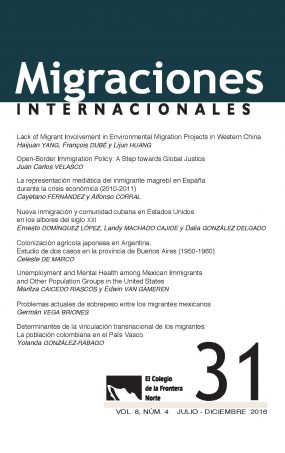La falta de involucramiento de los migrantes en proyectos de migración ambiental en China Occidental
DOI:
https://doi.org/10.17428/rmi.v8i4.625Palabras clave:
migración ambiental, migración forzada, gobernanza, Ningxia, ChinaResumen
Las políticas de migración forzada debida a la degradación ambiental exponen a los emigrantes a un número de riesgos potenciales. Este artículo apunta a explorar la contribución de la gobernanza institucional y la participación de emigrantes para la mitigación de estos riesgos. Con base en una encuesta empírica llevada a cabo en dos pueblos en la provincia de Ningxia de China, consideramos las relaciones interactivas de los emigrantes y el gobierno local, y hallamos que la naturaleza participativa de las instituciones locales juega un rol fundamental en determinar el éxito de las políticas de migración. Por ende, los riesgos de desubicación social no son consecuencias inevitables impuestas sobre los emigrantes: cuando se les da la oportunidad, ellos se pueden adaptar e influenciar los proyectos con el fin de mitigar los riesgos a los que son expuestos.
Referencias
BAI, Xue-Jun, and Li WEN, 2013, “An Effectiveness Analysis on Policy of Eco-migration in Ningxia and Reflections of Constructing a New Harmonious and Prosperous Ningxia,” Research of Agricultural Modernization, Vol. 2, No. 2, pp. 159–162.
BANKS, Tony; Camille RICHARD, Li PING, and Yan ZHAOLI, 2003, “Community-Based Grassland Management in Western China: Rationale, Pilot Project Experience, and Policy Implications,” Mountain Research and Development, Vol. 23, No. 2, pp. 132–140.
BAO, Zhi-Ming, 2006, “The Definition, Category and Some Other Issues about Ecological Migration,” Journal of The Central University For Nationalities, No. 1, pp. 27–39.
BARNETT, Jon, and Saffron O’NEILL, 2010, “Maladaptation,” Global Environmental Change, No. 20, pp. 211–213.
BARTOLOME, Leopoldo Jose; Chris DE WET, Harsh MANDER, and Vijay Kumar NAGRAJ, 2000, “Displacement, Resettlement, Rehabilitation, Reparation, and Development,” WCD Thematic Review I.3, prepared as an input to the World Commission on Dams, Cape Town, www.dams.org.
CERNEA, Michael, 1997, “The Risks and Reconstruction Model for Resettling Displaced Populations,” World Development, Vol. 25, No. 10, pp. 1569–1588.
CHEN, Guojia, 2007, “Strategic Thoughts and Suggestions of Eco-Migration in China,” Decision and Consulting Letter, No. 5, pp.1–4.
DÉMURGER, Sylvie, and Haiyuan WAN, 2012, “Payments for Ecological Restoration and Internal Migration in China: The Sloping Land Conversion Program in Ningxia,” IZA Journal of Migration, Vol. 1, No. 10, pp. 1–22.
DICKINSON, Debbie, and Michael WEBBER, 2007, “Environmental Resettlement and Development on the Steppes of Inner Mongolia, PRC,” Journal of Development Studies, Vol. 43, No. 3, pp. 537–561.
DOWNING, Theodore E., 1996, “Mitigating Social Impoverishment when People are Involuntarily Displaced,” in Christopher McDowell, ed., Resisting Impoverishment: Tackling the Consequences of Development-induced Impoverishment, Oxford, Bergham Books, pp. 33–48.
FOGGIN, Jean-Marc, 2008, “Depopulating the Tibetan Grasslands,” Mountain Research and Development, Vol. 28, No. 1, pp. 26–31.
FOGGIN, Jean-Marc, and Marion TORRANCE-FOGGIN, 2011, “How Can Social and Environmental Services be Provided for Mobile Tibetan Herders? Collaborative Examples from Qinghai Province, China,” Pastoralism: Research, Policy and Practice, Vol. 1, No. 21.
GEMENNE, François, 2009, “L’environnement, nouveau facteur de migrations?” in Christophe Jaffrelot and Christian Lequesne, eds., L’enjeu mondial: les migrations, Paris, Presses de Sciences Po., pp. 137–145.
GEMENNE, François; Pauline BRÜCKER, and Dina IONESCO, 2012, The State of Environmental Migration 2011, IDDRI.
GRUSCHKE, Andreas, 2012, “Tibetan Pastoralists in Transition. Political Change and State Interventions in Nomad Societies,” in Hermann Kreutzmann, ed., Pastoral Practices in High Asia: Agency of ‘Development’ Effected by Modernisation, Resettlement and Transformation, Dordrecht, Holland, Springer, pp. 273–289.
GUSTAFSSON, Bjorn, and Ding SAI [paper], 2012, “Assessing Ethnic Disparities in Income and Poverty in China: The Case of Han and Hui in Ningxia,” 32nd General Conference of The International Association for Research in Income and Wealth, Minnesota, October 11–13, 2012.
INTERGOVERNMENTAL PANEL ON CLIMATE CHANGE, 2007, “Climate Change 2007: Impacts, Adaptation and Vulnerability”, Contribution of Working Group II to the Fourth Assessment Report of the Intergovernmental Panel on Climate Change, Cambridge, Cambridge University Press, accessed May 21, 2015.
IREDALE, Robyn, Naran BILIK, and Fei GUO, 2003, China's Minorities on the Move: Selected Case Studies, Armonk, NY/London, M.E. Sharpe.
LI, Lihua; Chenggang WANG, Eduardo SEGARRA, and Zhibiao NAN, 2013, “Migration, Remittances, and Agricultural Productivity in Small Farming Systems in Northwest China,” China Agricultural Economic Review, Vol. 5, No. 1, pp. 5–23.
LIAO, Chuan; Stephen J. MORREALE, Karim-Aly S. KASSAM, Patrick J. SULLIVAN, and Ding FEI, 2014, “Following the Green: Coupled Pastoral Migration and Vegetation Dynamics in the Altay and Tianshan Mountains of Xinjiang, China,” Applied Geography, No. 46, pp. 61–70.
LIU, Yihai, and Qiong WANG, 2001, “Suitable Distribution of China’s Population,” China Population, Resources and Environment, Vol. 11, No. 1, pp. 34–37.
LIU, Jianguo; Shuxin LI, Zhiyun OUYANG, Christine TAM, and Xiaodong CHEN, 2008, “Ecological and Socioeconomic Effects of China's Policies for Ecosystem Services,” Proceedings of the National Academy of Sciences, Vol. 105, No. 28, pp. 9477–9482.
MCDONALD, Brooke; Michael WEBBER and Yuefang DUAN, 2004, “Involuntary Resettlement as an Opportunity for Development: The Case of the Urban Resettlers at the Three Gorges Dam in China,” Journal of Refugee Studies, Vol. 21, No. 1, pp. 82–102.
MCLEMAN, Robert, and Lori HUNTER, 2010, “Migration in the Context of Vulnerability and Adaptation to Climate Change: Insights from Analogues,” Wiley Interdisciplinary Reviews: Cli mate Change, May-June; Vol. 1, No. 3, pp. 450–461, accessed May 21, 2015.
MOL, Arthur, 2006, “Environment and Modernity in Transitional China: Frontiers of Ecological Modernization,” Development and Change, Vol. 37, No. 1, pp. 29–56.
NASRITDINOV, Emil; Mehrigul ABLEZOVA, Jypara ABARIKOVA, and Aigoul ABDOUBAETOVA, 2010, “Environmental Migration: Case of Kyrgyzstan,” Environment, Forced Migration and Social Vulnerability, Berlin, Heidelberg, Springer Berlin Heidelberg, pp. 235–246.
PADOVANI, Florence, 2004, “Migrations forcées et grands travaux hydrauliques en Chine: le cas du barrage des Trois Gorges,” Géocarrefour, Vol. 79, No. 1, pp. 27–34.
PINGLIANG COMMISSION FOR AGRICULTURAL WORKERS, 2014, “Overall Research Report on the Relocation of Ecological Migrants in Pingliang,” CPC Provincial Office of Rural Work in Gansu, accessed May 20, 2015.
POVERTY ALLEVIATION OFFICE, 2012, “List of Key Counties for National Poverty Alleviation and Development Work,” Central Government Official Website, accessed May 20, 2015.
ROGERS, Sarah, and Mark WANG, 2006, “Environmental Resettlement and Social Dis/Rearticulation in Inner Mongolia, China,” Population and Environment, Vol. 28, No. 1, pp. 41–68.
SHI, Guo-qing; Zhou JIAN, and Li JING-YI, 2007, “Protection of Rights and Interests and Government’s Responsibilities: A Case Study of the Tarim River Ecological Migration as an Example,” Jilin University Journal Social Sciences, No. 47, pp. 78–86.
SHI, Sui, 2008, “Living Condition and Social Adaptation of Sanjiangyuan Eco-Migration: Taking Case of Eco-Migration in Golmud City from Changjiang Source,” Tibetan Studies, No. 4, pp. 93–102.
SONG, Fan, 2000, “Strategies for the ‘Aid-the-Poor’ Migration Program in Ningxia Autonomous Region,” Human Geography, Vol. 15, No. 5, pp. 47–51.
TAN, Yan, and Yi Qian WANG, 2004, “Environmental Migration and Sustainable Development in the Upper Reaches of the Yangtze River,” Population and Environment, Vol. 25, No. 6, pp. 613–636.
TAN, Yan, and Xuchun LIU [paper], 2013, “In Situ Adaptation and Out-Migration: Enablers and Constraints Among Rural Households of the Mountainous Region of Southern Ningxia, Northwest China,” XXVII IUSSP International Population Conference, Busan, South Korea, August 26–31.
TAN, Yan; Alec ZUO, and Graeme HUGO, 2013, “Environment- Related Resettlement in China: A Case Study of the Ganzi Tibetan Autonomous Prefecture of Sichuan Province,” Asian and Pacific Migration Journal, Vol. 22, No. 1, pp. 77–107.
TANG, Hong; DeGang YANG, XinHuan ZHANG, and XinYi XIANG, 2012, “Ecological Migration Effects on the Tianchi Scenic Area in Xinjiang: From the Perspective of Migrant Farmer Families,” Journal of Arid Land, Vol. 4, No. 1, pp. 95–104.
WANG, Zongming; Kaishan SONG, and Liangjun HU, 2011, “Response to ‘Rethinking Ecological Migration and the Value of Cultural Continuity,’” AMBIO: A Journal of the Human Environment, Vol. 40, No. 1, pp. 100–101.
WEBBER, Michael, and Brooke MCDONALD, 2004, “Involuntary Resettlement, Production and Income: Evidence from Xiaolangdi, PRC,” World Development, Vol. 32, No. 4, pp. 673–690.
WEST, Jennifer J., 2009, “Perceptions of Ecological Migration in Inner Mongolia, China: Summary of Fieldwork and Relevance for Climate Adaptation,” Oslo, Norway, CICERO Report 2009:05.
WILMSEN, Brooke; Michael WEBBER, and Yuefang DUAN, 2011, “Involuntary Rural Resettlement: Resources, Strategies, and Outcomes at the Three Gorges Dam, China,” The Journal of Environment and Development, Vol. 20, No. 4, pp. 355–380.
XUE Xin-le, LIU Zhi-Ping, and TIAN Guo-Jiang, 2011, “Study on Ecological Restoration and Management Problems of Ecological Out-migration area in Longde County of Ningxia,” Journal of Gansu Forestry Science and Technology, Vol. 36, No. 4, pp. 53–54.
WU, Zhandong, 2012, “Report on the Implementation of the ‘12th Five Year Plan’ of Ecological Migration in South-Central Ningxia,” Bureau of Immigration of the Ningxia Autonomous Region.
ZHAN, Xiao Lin, 2008, “Study on the Value Estimation and Compensation Mechanism of Ecological Migration in Sanjiangyuan Area,” Ascent, No. 6, pp. 66–69.
Descargas
Publicado
Número
Sección
Licencia
Las/los autoras/es que publiquen en esta revista aceptan las siguientes condiciones:
- Las/los autoras/es conservan los derechos de autor y ceden a la revista Migraciones Internacionales (RMI) el derecho de la primera publicación, mediante el registro de los textos con la licencia de Creative Commons Atribución-No comercial-Sin derivar 4.0 internacional (CC BY-NC-ND 4.0), que permite a terceros utilizar lo publicado siempre que mencionen la autoría del trabajo y a la primera publicación en esta revista.
- Autorizan que su artículo y todos los materiales incluidos en él sean reproducidos, publicados, traducidos, comunicados y transmitidos públicamente en cualquier forma o medio; así como efectuar su distribución al público en el número de ejemplares que se requieran y su comunicación pública, en cada una de sus modalidades, incluida su puesta a disposición del público a través de medios electrónicos o de cualquier otra tecnología, para fines exclusivamente científicos, culturales, de difusión y sin fines comerciales.
- Los autores/as pueden realizar otros acuerdos contractuales independientes y adicionales para la distribución no exclusiva de la versión del artículo publicado en esta revista (por ejemplo: incluirlo en un repositorio institucional, página web personal; o bien publicarlo en un libro) siempre que sea sin fines comerciales e indiquen claramente que el trabajo se publicó por primera vez en Migraciones Internacionales (RMI), [agregando la ficha bibliográfica correspondiente: Autor/es. (año). Título del artículo. Migraciones Internacionales, volumen (número), pp. doi: xxxx ].
Para ello, las/los autoras/es deben remitir el formato de carta-cesión de la propiedad de los derechos de la primera publicación debidamente llenado y firmado. Este documento debe cargarse en formato PDF en archivos complementarios dentro de la plataforma OJS.
Este obra está bajo una licencia de Creative Commons Atribución-No comercial-Sin derivar 4.0 internacional (CC BY-NC-ND 4.0)..













